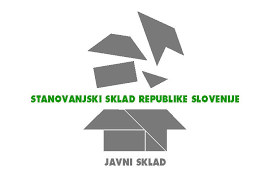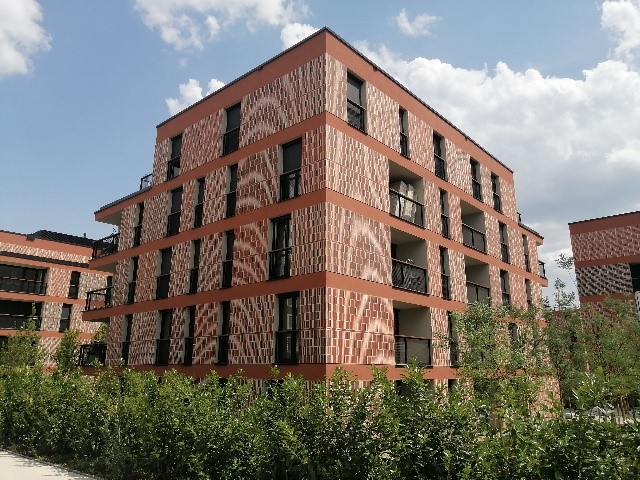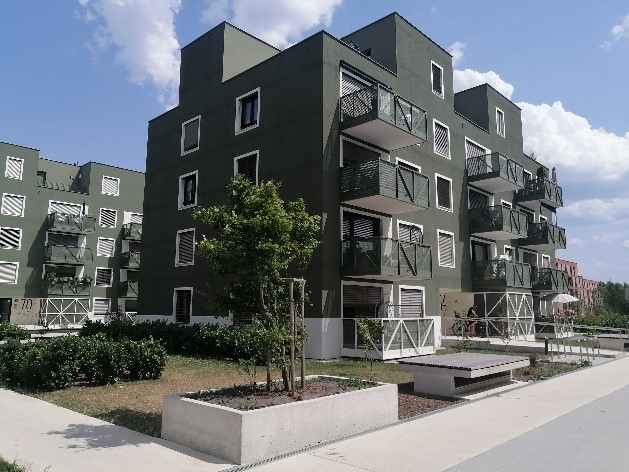Housing Fund of the Republic of Slovenia
Created on 16-05-2022 | Updated on 04-07-2023
The National Housing Fund of the Republic of Slovenia was founded in October 1991 under the National Housing Act with its main role being to oversee the implementation of the National Housing Programme in collaboration with other governmental bodies and agencies on a national and municipal level. The National Housing Fund was created over 30 years ago now and in this period it has sold almost 3,000 housing units at favourable prices to families struggling to find affordable homes and currently manages over 3,800 public rental apartments across the country. Within the current National Housing Programme, the National Housing Fund aims to acquire 500 public rental apartments, 150 serviced rental apartments, and 50 places in homes for seniors and acquire up to 3,280 public rental apartments for young families.
Instrument
Regulation, subsidy, incentive, policy
Issued (year)
1991
Application period (years)
1991-2025
Scope
The Republic of Slovenia
Target group
young, first time buyers, elderly, low income group, other vulnerable groups
Housing tenure
public rental housing, social rental housing, co-housing, affordable homeownership
Discipline
economics, public policy
Object of study
Cross-country comparison
Description
National Housing Fond of the Republic of Slovenia: from inception to present day
The Republic of Slovenia proclaimed its independence in 1991, and the new state was obliged to create proper housing for its citizens. The National Housing Fund of the Republic of Slovenia (the Fund) was founded in October 1991 under the National Housing Act (the Act) in order to oversee the implementation of the National Housing Programme (NHP) in collaboration with other governmental bodies and agencies at a national and municipal level (HFRS, 2021; European Commission, 2017). According to the Act, the proceedings from the privatisation were to be distributed as follows: 20% to the Fund, 30% refunded to tenants that relinquished the rights to purchase dwellings and 50% to purchase new housing (Sendi, 1995). The NHP aimed to ensure a higher standard of living for vulnerable groups. According to Kerbler and Kolar (2018), the four main objectives of the NHP are to create a balanced supply of suitable housing, to facilitate access to housing, to improve the quality and functionality of housing and to increase the residential mobility of the population. Over the years, the Fund's tasks have extended from policy implementation to investment, management and construction activities.
After Slovenia gained independence in 1991, there was a massive privatisation of the public housing stock (Cirman, 2017). Overseeing the privatisation was one of the first tasks for the newly created Fund in Slovenia, as the role of the state in the housing market was slowly diminishing (Cirman & Mandič, 2013). Provisions from the privatisation of public dwellings were allocated to the Fund, and over the period of 30 years of the Fund’s existence, almost 3,000 housing units were sold at favourable prices (HFRS, 2021).
Originally, one of the Fund’s main tasks was to provide favourable loans (around 3%) mainly to non-profit housing organisations so that they could construct housing units to accommodate young families with children, single-income families, the physically handicapped and three-generation households (Sendi, 1995).
At present, there is a ten-year strategy in place, which is set to finish in 2025, that aims to increase the supply of dwellings and to support disadvantaged and vulnerable people
The Fund's main activities currently include promoting investment in new construction to increase the public rental housing stock through long-term loans, housing saving schemes, direct investment in projects, management of the existing housing stock and the development of pilot projects. (HFRS, 2021). Under the NHP, for each public dwelling sold, the Fund is obliged to dedicate one dwelling for rental use (Cirman, 2017). The Fund develops its own projects as well as projects in cooperation with municipal housing associations and housing cooperatives. The current strategy runs from 2015 to 2025 and focuses on renewing the housing stock, increasing affordability through various financial instruments such as mortgage insurance and building new housing (BMVBS, 2009; European Commission, 2017). Among other objectives, the Fund plans to acquire up to 500 public rental housing units, 150 assisted rental housing units and 50 places in retirement homes, as well as up to 3,280 public rental housing units for young families in the period 2021-2025.
One of the recently completed projects co-financed by the Fund is the construction of housing for young people and seniors in the city of Ljubljana. The Housing Fund received a favourable loan of €50 million from the Council of Europe Development Bank (CEB) for the construction of 500 rental flats for 498 families and individuals. According to the director of the Housing Fund, Črtomir Remec, on its completion in 2021, this will be the "largest housing construction in independent Slovenia". Some similar projects are in the development phase while others are scheduled to start in the near future, co-financed by the CEB and the Housing Fund. Moreover, around €60 million for affordable housing has been obtained from European Commissions Recovery and Resilience Fund.
The Funds’ structure
The founding body of the Fund is the Republic of Slovenia. It is governed by a supervisory board consisting of two members of the Ministry of Spatial Planning, one member of the Ministry of Finance, one member of the beneficiaries and one member of the legal department. In addition to the Fund, there are 13 registered municipal public funds in Slovenia that are responsible for implementing municipal housing programmes.
The day-to-day operations of the Fund are managed by 40 employees (31 December 2020) and the total assets of the Fund amount to more than €400 million (HFRS, 2021).
The main sources of funding come from the sale of housing units, transfers from the state budget, foreign and domestic grants, the issuance of the Fund's securities, the sale of other non-operating assets under the Fund's management, and income from the rental of housing and long-term loans. The Fund owns two subsidy companies, a building management company and a property consultancy company, employing around 30 and 20 people respectively. At the end of 2020, there were 3,825 public rental housing units managed by the Fund. It is modernising its platform to better manage rental housing applications (HFRS, 2021).
Shortcomings of the Fund’s operations
At the beginning of the Fund's operation in the early 1990s, the Minister of Environment, who was one of the authors of the Housing Act on the basis of which the Housing Funds had been established, claimed that 20% of the proceeds from the sale of the housing stock owned by the local authorities had not been paid into the Housing Fund by the local authorities, as stipulated in the Act. Due to the lack of these funds, the objectives of the fund were not achieved in the first years of its operation and its development was hampered. (Sendi, 1995). Other observations by the European Commission (2017) state that the programme is not on the right track because of the lack of legislation to facilitate new pilot projects and innovative solutions. This report also points to the underfunding of the fund. It estimates that at least 220 million euros are needed to achieve the goals, while claiming that the administration, with 40 staff, is not sufficiently staffed to fulfil all the tasks. Moreover, since the rentals the Fund charges are below market levels, it has difficulty attracting private companies to invest in social housing. The last remark in the report is that homeless people, people who have been evicted and live in overcrowded flats, do not fall within the scope of the fund's activities (see also FIlipovič Hrast, 2019).
Final remarks
Compared to neighbouring EU Member States, namely Croatia, the Fund is seen as an innovation in the context of the post-privatisation period. For example, after its privatisation in the early 1990s, Croatia sold almost all of its public housing stock without developing a vision or strategy to reinvest the proceeds in affordable housing. In contrast, Slovenia had the institutional capacity to establish a national governing body to oversee and implement the housing strategy and take responsibility for the construction and maintenance of the public and social housing stock. Since then, the Fund has become the cornerstone of any future housing policy development. With its 30 years of experience and expertise, the Fund is an example of best practise and a goal that countries with similar circumstances should strive for, namely post-socialist countries with high levels of home ownership and a non-existent national housing strategy.
Alignment with project research areas
The case of the Housing Fund of the Republic of Slovenia is related to the three project research areas: “Design, planning and building”, “Community participation” and “Policy and financing”. Each project research area is subdivided into categories; in the sections below, only subcategories that are relevant to this case study are explained.
Design, planning and building
Under the research area "Design, planning and building", this case mainly considers the subcategory "Sustainable Planning". Sustainable planning is mainly included in the long-term objectives and code of conduct set out in the Fund's strategy, which is currently valid until 2025. An example of sustainable planning is the Fund's internal document in Annex 2, Measure 6.1 entitled "Sustainable construction and renovation in the provision of public rental housing and in the management of SSRS-owned housing/facilities", which states that only materials that are "environmentally sound, durable and resilient" will be used in the construction of buildings. The Fund plans to pursue this goal by conducting a life-cycle cost assessment of multifamily housing (HFRSa, 2021).
Policy and Financing
Within the research area "Policy and financing", the sub-category "Governance, market and finance" mainly refers to this case study. As mentioned in the previous section, the operations of the funds recognise the sustainability aspect of construction in terms of financing. There are other operations, such as 3.4, in which the Fund acquires land or housing that it then offers for rent to vulnerable groups, namely young and elderly people in need of special services. In general, one of the Fund's main tasks is to co-finance projects with local authorities to build affordable housing. In particular, in the context of governance, the Fund aims to establish a public rental management service (Measure 2.1) to improve affordability through the possible introduction of tax incentives and reliefs for tenants using this service (HFRSa, 2021).
Community participation
There are two related subcategories in this research area: inclusive design and community planning. An example of inclusive design is that the Fund builds housing in central and well-connected areas near city centres to ensure proximity to various public services. In addition, flats for residents with limited mobility, such as wheelchair users, are located on the ground floor to facilitate access, while all buildings have lifts in case someone with limited mobility lives on higher floors. As far as community planning is concerned, the Fund proceeds with the allocation of flats according to the applicant list, which is also an indicator of housing demand. There are more applicants on the list than flats available, but the number on the list is used to project future building plans. In many projects, the Fund and the local communities are jointly involved and share the costs of construction. In such a case, the Fund relies on the specific knowledge of the local context regarding the needs of the community and plans the project accordingly (HFRS, 2021). Finally, some of the dwellings built by the Fund allow for shared indoor spaces that are used by the residents, which contributes to a more inclusive and participatory neighbourhood life.
* This diagram is for illustrative purposes only based on the author’s interpretation of the above case study
Alignment with SDGs
The Housing Fund of the Republic of Slovenia is addressing three SDGs particularly:
SDG 1: End poverty in all its forms everywhere
The Housing fund is improving the living conditions of the youth and elderly, and reducing the risk of poverty and social exclusion by offering affordable housing. With a raise in precarious working relations for young generations and low pensions to elderly, the flexibility of service that the Fund is offering is addressing the work mobility through the public and social rental scheme in many large urban conglomerations. Due to a high risk of poverty among the youth and the elderly, the Housing fund is a notable example of addressing the issue, with further efforts to be made, such as regulation and tax incentive for land transfer and intergenerational cooperation.
SDG 7: Ensure access to affordable, reliable, sustainable and modern energy for all
According to the literature found on the Fund and from the documents sent by the Fund directly (internal publications), the Fund is addressing this issue with modern construction materials and methods, which could lead towards reducing the energy poverty. The Fund considers the life cycle in construction, and promotes sustainable methods in the maintenance of the housing units. There could be an improved strategy showing targets to be reached by the Fund to show a higher commitment.
SDG 11: Make cities inclusive, safe, resilient and sustainable
The Funds’ activities promote social mix in their operations by including social and public rental and home ownership tenure in the same area. Moreover, by investing in both rural and urban regions, the Fund promotes balanced development. Due to an increase of overall housing prices in Europe, the increase in the supply of social and rental housing units by the Fund could lead to reducing the overall housing prices, thus increasing the affordability and accessibility.
References
CEB. (n.d.) (2021). Governor Wenzel opens Novo Brdo housing complex in Ljubljana together with
Slovenia’s Environment Minister Andrej Vizjak Retrieved March 17, 2022, from https://coebank.org/en/news-and publications/news/governor-wenzel-opens-novo-brdo-housing-complex-in-ljubljana/
Cirman, A. (2017). “Just another” or a “genuine” change in the Slovenian social housing strategy?. Critical Housing Analysis, 4(1), 102-111. DOI:10.13060/23362839.2017.4.1.329
Cirman, A., & Mandič, S. (2013.) Slovenia: The Social Housing Sector in Search of an Identity. Pp. 278-291 in J. Hegedüs, M. Lux, N. Teller (eds.) Social Housing in Transition Countries. New York, London: Routledge.
European Commission. (2017). European Construction Sector Observatory, Policy Fact Sheet, Slovenian National Housing Programme, Thematic Objectives 1&3. European Union, June, 27.
https://ec.europa.eu/docsroom/documents/34903?locale=hr
Federal Ministry of Transport, Building and Urban Affairs/ Federal Institute for Research on Building, Urban Affairs and Spatial Development of Germany (BMVBS/BBSR) (2009). Urban Development Funds in Europe Ideas for implementing the JESSICA Initiative. BBSR-Online-Publikation, Nr. 03/2009.
FIlipovič Hrast, M. (2019). Challenges to Development of Policy on Homelessness in Slovenia, European Journal of Homelessness, vol. 13, No. 2, 2019
Housing fund of the Republic of Slovenia (HFRS). (2021). Business policy of the housing fund of the
republic of Slovenia 2021-2025, internal publication (Issue January, 2021).
Housing Fund of the Republic of Slovenia (HFRS) (2021a): Annex 2: Matrix of business objectives of the Housing Fund of the Republic of Slovenia in the years 2021−2025 [internal publication]
Kerbler, B., & Kolar, B. (2018). Housing for Younger and Older Populations. Housing.
https://doi.org/10.5772/intechopen.78039
Sendi, R. (1995). Housing reform and housing conflict: the privatization and denationalization of public housing in the Republic of Slovenia in practice. International Journal of Urban and Regional Research, 19(3), 435–446. https://doi.org/10.1111/j.1468-2427.1995.tb00519.x
Related vocabulary
Housing Governance
Area: Policy and financing
Created on 16-02-2022
Read more ->



